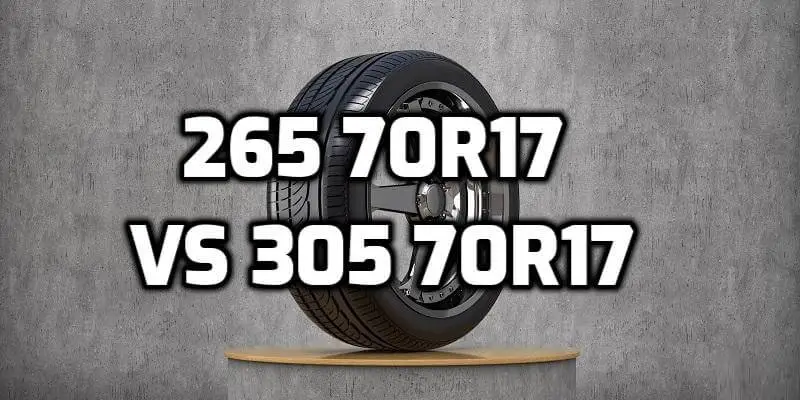265/70r17 vs 305/70r17 Tire Size

The difference is between a 265 70r17 tire and a 305 70r17 tire. Both of these sizes are popular choices for off-road vehicles. Still, there are some key differences that you should know about before making your purchase. In this blog post, we will discuss the pros and cons of each size so that you can make an informed decision about which one is right for you.
265 70r17 vs 305 70r17 Table
[wptb id=721]
What Does 265 70r17 tire Mean?
The 265 70r17 tire size is a popular choice for off-road vehicles. It is a metric tire, which means that it is measured in millimeters. The first number, 265, is the width of the tire. The second number, 70, is the aspect ratio.
This means that the tire is 70% as tall as the comprehensive. The R in the size designation stands for radial, which is the type of construction used in most modern tires. The 17 is the diameter of the tire in inches.
Tire Width
The main difference between 265 70r17 and 305 70r17 Tire is the width. The 265 is about two inches narrower than the 305. The 265 70r17 tires are 265mm wide, whereas the 305 70r17 tires are 305mm broad.
This can significantly affect how your vehicle handles, especially when driving off-road. A narrower tire will provide better traction in mud and sand, but it will also be more susceptible to punctures.
Aspect Ratio
Another difference between these two sizes is the aspect ratio. The 265 70r17 has an aspect ratio of 70, which means it is 70% as tall as it is wide, which is 185.5mm. The 305 70r17 has an aspect ratio of 70, meaning it is 70% as tall as it is wide, 213.5mm.
A tire’s sidewall height affects several things, including its load-carrying capacity and air volume. A taller sidewall will give you a smoother ride, making your vehicle more susceptible to rollover. A shorter sidewall provides better handling and stability, but it can make your ride feel harsher. You will want to consider the aspect ratio when choosing tires for your off-road vehicle.
Construction Type
The letter R in 265 70r17 and 305 70r17 stands for radial, which is the most common type of tire construction. Radial tires are made with plies that run perpendicular to the direction of travel.
This gives radial tires superior strength and durability, which is why they are the preferred choice for most vehicles. You should pay attention to the R in the size designation when shopping for tires.
Rim Size
The last number in the 265 70r17 and 305 70r17 tire size designation is the diameter of the rim in inches. The 17 in-size designation means the tire will fit on a 17-inch rim.
This is important to know because you will need to purchase rims that are the correct size for your tires. You need to double-check the size of the rims on your vehicle to ensure you are buying the right tires.
Circumference
The circumference of a tire is the distance around the outside of the tire. The 265 70r17 has a circumference of 99.29 inches, and the 305 70r17 has a circumference of 106.22 inches.
This is important to know because it can affect the speedometer reading on your vehicle. Suppose the circumference of your tires is different than what is listed on your vehicle. In that case, you will need to have the speedometer recalibrated.
Revolutions Per Mile
The number of revolutions per mile (RPM) measures how far a tire will travel in one mile. The 265 70r17 has an RPM of 396.5, and the 305 70r17 has an RPM of 370.64.
This is important to know because it can affect your fuel economy. A tire with a higher RPM will travel further in one mile, which can lead to better fuel economy.
Our Observation
The width, aspect ratio, construction type, and rim size are all important things to consider when shopping for tires. Now that you know the difference between 265 70r17 and 305 70r17, you can decide which size is right for your vehicle. I hope this blog post was helpful! If you have any questions, please feel free to leave a comment below. I would be happy to answer them!
Related Article

Meet Caitlin McCormack, a Tire Size Expert and Blogger Passionate About Everything Related to Tires. With Years of Experience in the Tire Industry, Caitlin Has Become an Expert in Tire Sizes and Their Impact on Vehicle Performance.
